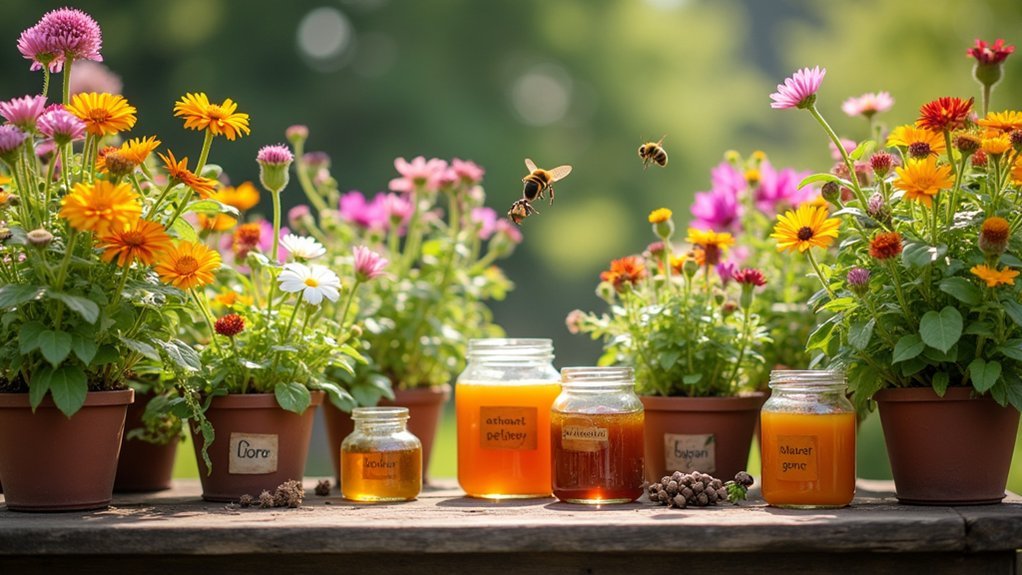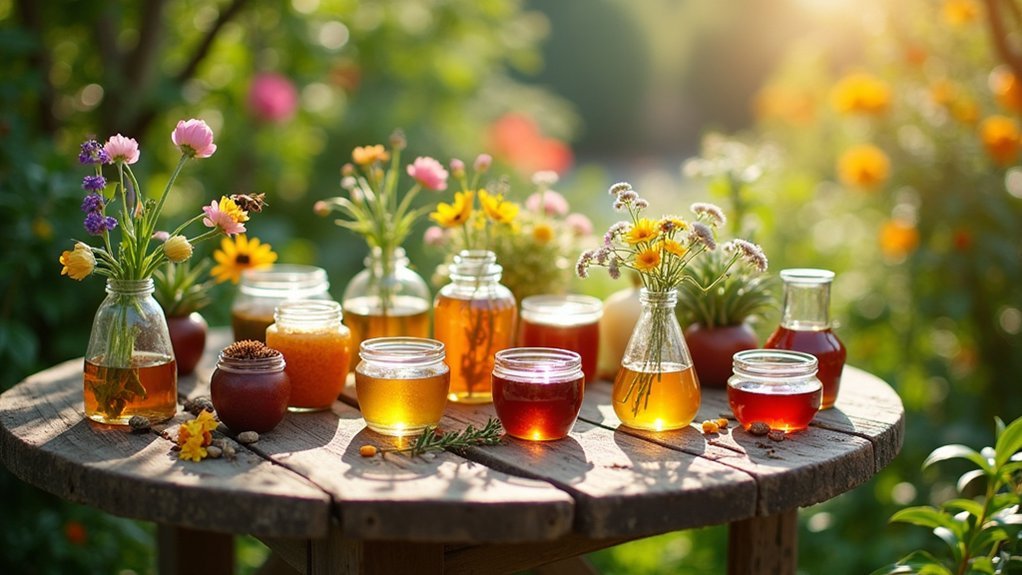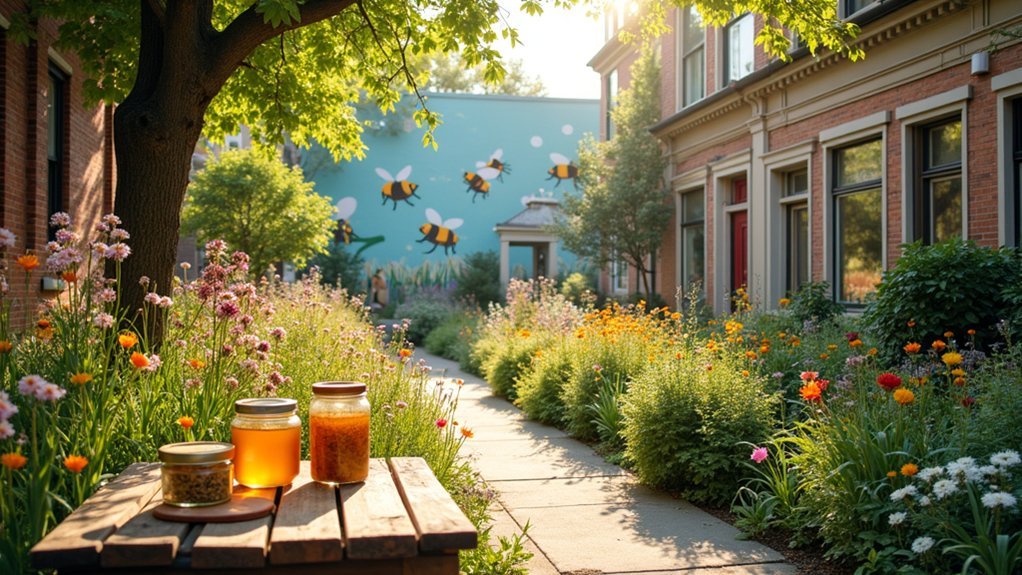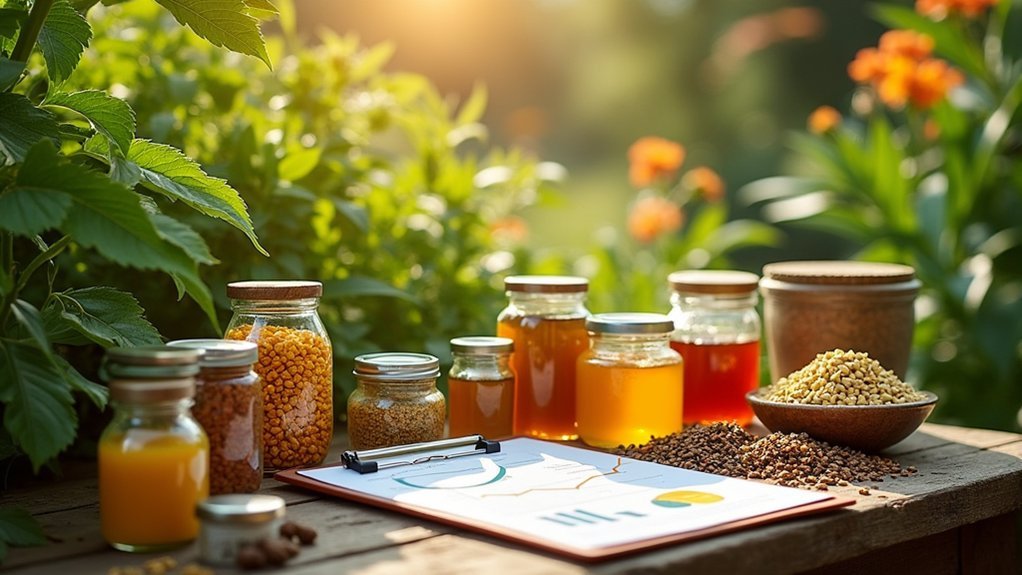Neighborhood bee food exchange programs are community networks where you can trade honey, bee products, and pollinator-friendly plants with local beekeepers and gardeners. You'll participate in informal swap meets or organized events that promote bee conservation while enhancing local food security. These exchanges foster community connections, support biodiversity, and provide educational opportunities about pollinators' vital role in our food system. Discover how these grassroots initiatives transform ordinary neighborhoods into thriving pollinator corridors while building resilient communities.
What Are Neighborhood Bee Food Exchange Programs?

While many urban sustainability initiatives focus on community gardens or farmers' markets, Neighborhood Bee Food Exchange Programs represent a unique approach to local food systems.
These programs create networks where you can trade locally produced honey and bee products with neighbors, fostering community connections and supporting local beekeepers.
You'll find these exchanges operating as informal swap meets or organized community events where participants share excess honey for other food items. This system enhances food security by distributing resources equitably among community members.
As you participate, you'll learn about bee conservation and the vital role pollinators play in our food supply.
These programs are particularly valuable in underserved neighborhoods, where they promote food justice while strengthening community bonds through shared sustainability practices.
The Growing Movement of Community Pollinator Networks
You'll find Local Nectar Trading Systems emerging in neighborhoods nationwide, where residents exchange honey varieties and share pollinator-friendly plants to strengthen local food webs.
Cross-Pollination Support Networks connect beekeepers with gardeners, creating mutually beneficial relationships that enhance biodiversity and crop yields throughout communities.
Seasonal Flower Cooperatives coordinate planting schedules to guarantee year-round forage for bees, often mapping "nectar corridors" that support pollinator migration and resilience against climate fluctuations.
Local Nectar Trading Systems
The buzz around Local Nectar Trading Systems has grown steadily as neighborhoods across the country establish community-driven initiatives to exchange honey, pollinator-friendly plants, and beekeeping knowledge.
These systems strengthen your local food resilience by connecting urban beekeepers with community gardens and residents seeking pollination services.
When you participate in a local bee exchange network, you'll typically experience:
- Direct access to diverse honey varieties, beeswax, and pollen produced within your neighborhood
- Opportunities to trade native flowering plants that support pollinator habitats
- Knowledge-sharing workshops where experienced beekeepers demonstrate sustainable practices
These community-centered systems empower you to take an active role in supporting pollinator populations while enhancing biodiversity right in your backyard.
You'll build meaningful relationships with neighbors who share your interest in creating resilient, bee-friendly communities.
Cross-Pollination Support Networks
Beyond simple trading systems, Cross-Pollination Support Networks represent a significant evolution in community-based pollinator conservation.
These initiatives connect beekeepers, gardeners, and farmers in your neighborhood to share resources and knowledge about bee health and sustainable practices.
You'll find these networks encourage biodiversity through planting varied flowering species that bloom throughout the season, ensuring continuous food sources for pollinators.
Through educational workshops and community events, you'll learn essential beekeeping skills and pollinator conservation techniques.
The food exchange component allows you to trade honey, fruits, and vegetables with neighbors, strengthening local food systems.
Seasonal Flower Cooperatives
As awareness about pollinator decline has grown exponentially, seasonal flower cooperatives have emerged as grassroots solutions to create continuous bee food sources throughout the year.
You'll find community members coming together to share resources, knowledge, and native plants that support local bees while strengthening the food system.
By joining a cooperative, you're contributing to:
- Year-round blooming schedules – ensuring bees have access to nectar and pollen in every season
- Knowledge exchange networks – learning which flowering plants thrive in your specific region
- Food sovereignty initiatives – improving crop yields in underserved neighborhoods through enhanced pollination
These cooperatives don't just benefit bees—they're transforming communities by connecting food justice efforts with ecological restoration, creating resilient neighborhoods where pollinators and people thrive together.
How Bee Food Exchanges Strengthen Local Ecosystems
Neighborhood Bee Food Exchange Programs play a vital role in strengthening local ecosystems while creating sustainable community networks. When you participate in these exchanges, you're not just sharing honey—you're actively building biodiversity in your neighborhood.
These programs transform your community into educational hubs where neighbors learn about bee populations and their essential role in food production. You'll discover how planting diverse flowering species creates resilient pollinator habitats that benefit everyone.
As awareness grows, you'll notice more bee-friendly gardens appearing throughout your area. The ripple effect is significant: reduced pesticide use, increased plant diversity, and improved food security all stem from these collaborative efforts.
Setting Up Your First Neighborhood Plant Swap

Starting your first neighborhood plant swap begins with securing an accessible, central location and spreading the word through community channels like social media groups and local bulletin boards.
You'll want to establish clear guidelines for participants about acceptable plants, cuttings, and seeds to exchange, which helps prevent the spread of invasive species or plant diseases.
Enhance community engagement by offering light refreshments, organizing mini-workshops on plant care, or creating informational displays about native bee-friendly plants that support local pollinators.
Plant Exchange Basics
Everyone benefits when communities share their garden bounty. A neighborhood plant swap fosters community engagement while promoting biodiversity through the exchange of local varieties.
To establish your first successful exchange, focus on creating an organized, accessible event.
Choose a location that offers:
- Ample space for displaying plants and allowing participants to browse comfortably
- Protection from harsh weather conditions to keep plants and seeds safe
- Easy access for all community members, including those with mobility challenges
Establish clear guidelines about acceptable plants, required labeling, and post-event procedures for leftover items.
Consider adding educational components like mini-workshops on plant care. Promote your swap through community boards, social media, and local flyers to guarantee diverse participation and plant selection.
Community Engagement Tips
Why do successful plant swaps thrive? They flourish when community engagement becomes the foundation of your planning process.
Begin by gathering neighbors interested in sustainable gardening to discuss shared goals and logistics. This collaborative approach builds ownership and enthusiasm from the start.
Choose an accessible location with ample space, like a community garden or local park, where participants can comfortably display and exchange their offerings.
Promote your event through multiple channels—social media, community boards, and word-of-mouth—to reach diverse participants.
Enhance your swap with educational programming such as pollinator workshops or seedling care demonstrations. These learning opportunities help participants connect with nature while building practical skills.
Establish clear guidelines encouraging organic practices and proper plant labeling to guarantee everyone has a positive exchange experience.
Native Plant Species That Thrive in Urban Exchange Programs
While many urban gardeners struggle to find appropriate plants for their local pollinators, native species offer remarkable resilience and ecological benefits in neighborhood bee food exchange programs.
Native plants provide resilient, ecologically valuable options for urban gardeners seeking to support local pollinators through community exchanges.
When you participate in exchanges, focus on these native plant species that flourish in urban environments:
- Coneflowers and black-eyed Susans attract numerous pollinators with their bright, distinctive blooms while adapting well to city conditions.
- Milkweed varieties support both monarch butterflies and bees, making them dual-purpose food sources in exchange networks.
- Late-blooming asters and goldenrod provide critical nutrition for bees preparing for winter, extending your garden's ecological benefits into fall.
Seasonal Calendar for Optimal Bee Food Sharing

To maximize the impact of your neighborhood bee food exchange program, understanding nature's timing is crucial. Your efforts should align with local blooming cycles when bees are most active and hungry.
| Season | Months | Food Exchange Focus |
|---|---|---|
| Spring | Mar-May | Share early bloomers like crocuses and bluebells to jumpstart bee activity after winter |
| Summer | Jun-Aug | Exchange nectar-rich plants and honey during peak bee foraging months |
| Fall | Sep-Oct | Distribute late-blooming flowers to prepare bee colonies for winter |
Schedule community meetings seasonally to educate participants about maintaining year-round bee food sources. For best results, plant according to the seasonal calendar—March for early bloomers, June-July for summer favorites, and September for fall necessities. This synchronized approach guarantees bees receive consistent nutrition throughout their active cycles.
Building Community Through Shared Pollinator Gardens
Shared pollinator gardens serve as the beating heart of successful neighborhood bee food exchange programs. When you participate, you're not just growing plants—you're cultivating relationships while supporting local bee populations.
These gardens transform ordinary spaces into vibrant hubs of community engagement where neighbors exchange tools, seeds, and gardening wisdom.
Through shared pollinator gardens, everyday spaces bloom into lively centers where communities grow both plants and connections.
Your shared pollinator garden can:
- Create meeting spots where residents connect while learning about native plants that attract diverse bee species
- Serve as outdoor classrooms for workshops on sustainable gardening practices
- Provide essential food sources that support bees responsible for pollinating one-third of our food supply
Success Stories: Transforming City Blocks Into Bee Corridors

From inspiration to action, neighborhood bee food exchange programs have flourished across urban landscapes, producing remarkable success stories worth celebrating.
In cities like Detroit and Philadelphia, residents have transformed once-barren spaces into vibrant bee corridors that connect previously isolated green patches. These interconnected gardens have greatly boosted local bee populations while improving residents' access to fresh produce.
You'll find these success stories often begin with community-driven efforts, where neighbors collaborate to plant diverse flowering species that provide year-round nutrition for pollinators.
Educational workshops have proven essential to these initiatives, teaching residents about bee ecology and sustainable gardening practices. As participants witness increased pollinator activity in their neighborhoods, they're motivated to expand these corridors further, creating citywide networks of thriving bee habitats.
Urban Foraging Meets Bee Conservation: A Symbiotic Relationship
As urban residents explore local parks and community gardens for edible plants, they're simultaneously participating in a powerful conservation movement that strengthens bee populations.
When you join a neighborhood exchange program, you're creating a symbiotic relationship between urban foraging and bee conservation.
The connection manifests in three key ways:
- Your foraged fruits and herbs attract diverse bee species, creating natural pollination corridors throughout neighborhoods.
- Sharing excess produce reduces food waste while providing community members access to fresh, local food sources.
- The collective learning experience builds community resilience by connecting people through shared knowledge of local ecosystems.
Tracking and Measuring the Impact of Your Exchange Network

The true value of your neighborhood bee food exchange becomes apparent when you begin documenting its outcomes. As you collect data on honey production and shared resources, you'll create a compelling case for how bees play an essential role in community resilience.
| Metric | Collection Method | Impact Indicator |
|---|---|---|
| Product Quantity | Exchange logs | Food security level |
| Participant Numbers | Attendance records | Community engagement |
| Satisfaction | Surveys/feedback | Program value perception |
| Pollinator Population | Community science | Ecological health |
| Crop Yields | Partner monitoring | Food production success |
When tracking your exchange network, combine quantitative measures (pounds of honey shared) with qualitative feedback. Document how educational workshops increase crop yields in participants' gardens. This evidence-based approach will help you demonstrate tangible benefits to stakeholders and secure continued community support.
Frequently Asked Questions
How Many Bees Do You Need for a Tax Write-Off?
You don't need a specific number of bees, but you'll need at least one active honey bee colony generating income. You must demonstrate it's a business operation, not a hobby, with proper documentation.
What Is the 7/10 Rule in Beekeeping?
The 7/10 rule means you should maintain at least seven healthy colonies for every ten hives you manage. It's your buffer against colony losses, helping you guarantee continuity in honey production and pollination services.
What Is the 3 Feet 3 Mile Rule for Bees?
You'll find bees prefer foraging within 3 feet of their hive for efficiency, but they'll travel up to 3 miles when necessary. Plant diverse flowers nearby to support their preferred close-range foraging behavior.
What Is Beehive Program?
Beehive programs help you learn beekeeping while establishing hives in your community. You'll receive training, equipment, and mentorship to manage bees, which improves local food production and supports essential pollination in your area.
In Summary
You're now part of a growing revolution that's reconnecting urban spaces to natural systems. By swapping pollinator plants with neighbors, you've created stepping stones for bees across your community. Don't underestimate your impact—these small exchanges are rebuilding fragmented habitats and teaching future generations the value of biodiversity. Your neighborhood bee food exchange isn't just saving pollinators—it's rebuilding how we live together.





Leave a Reply